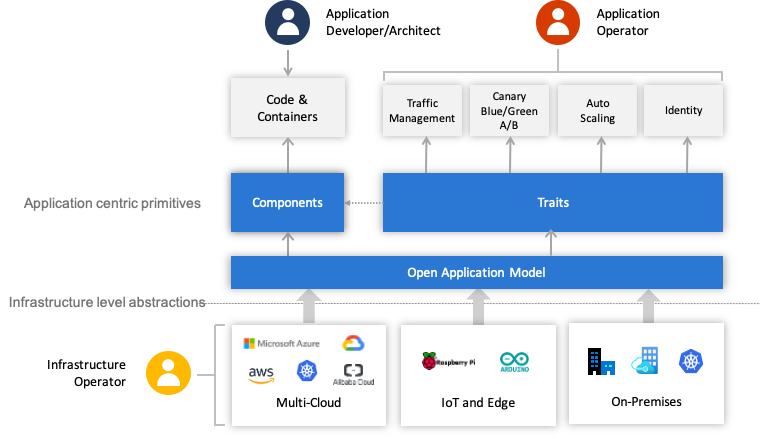Open Application Model (OAM) is a runtime-agnostic specification for building cloud native application platforms.
Focused on application rather than container or orchestrator, Open Application Model brings modular, extensible, and portable design for building application centric platforms on any runtime systems like Kubernetes, cloud, or IoT devices.
NOTICE: The current working draft of OAM specification (0.2.x release) is under pre-beta release, which means the specification is still under development but will keep backward compatibility for any further change.
Developers think in terms of application architecture, not of infrastructure.
Open Application Model defines a number of standard but extensible abstractions to model micro-service applications by natural, with operation configurations as part of the application definition. This enables platform builders to create platforms around a unified model, with app-centric mindset by default, and essentially changes building platforms into developing modularized components and traits for the application.
For platform builders who create the application platform, OAM provides Building Block Objects with:
- Application level abstractions - building developer facing platforms by default.
- Extensibility - bring your own abstractions or capabilities.
- Clarity and manageability - leveraging modularized and re-usable building blocks.
- No capability lock-in - decoupled abstractions and implementation.
For end users of the OAM based platform, OAM defines User Interface Objects that enable users to:
- Think applications, not containers or orchestrators.
- Build modern applications by default.
- Operation is part of the application lifecycle.
Open Application Model proposed a clear separation of concerns between the parts that developers are responsible for, and the parts that operators and platform engineers are responsible for. For more details, see introduction.md.
| Latest Release | Working Draft | |
|---|---|---|
| Core Specification: | ||
| OAM Specification | v0.2.1 | v0.2.2-WD |
- OAM Kubernetes Runtime is the officially maintained OAM plugin for Kubernetes which implemented OAM building block objects.
To get an overview of the milestones and their description please visit the Milestones page.
Triaging of items into milestones will occur during the bi-weekly community call. During this call, issues might be brought into milestones, removed from milestones or moved between milestones.
See the CONTRIBUTING guide for more information about submitting changes to the spec.
One of the easiest ways to contribute is to participate in discussions. There are several ways to get involved.
| Item | Value |
|---|---|
| Mailing List | https://groups.google.com/forum/#!forum/oam-dev |
| Community meeting info | Bi-weekly (Starting Oct 22, 2019), Tuesdays 10:30AM PST |
| Meeting link | https://zoom.us/j/271516061 |
| APAC Friendly Community meeting | Bi-weekly APAC (Starting May 19, 2020), Tuesdays 19:00PM GMT+8 |
| Meeting link APAC Friendly meeting | https://zoom.com.cn/j/2847572020 |
| Meeting notes | Notes and agenda |
| Meeting recordings | Recordings |
| IM Channel | https://gitter.im/oam-dev/ |
| @oam_dev |
Come find community blogs and conference talks about OAM in community talks and blogs.


